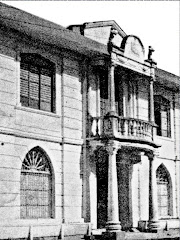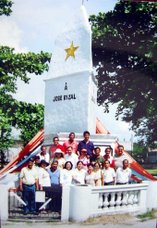History of Daet

Daet is an ancient settlement. Its history dates back from the time the Tabon cave men, from either Kalanay Caves of Masbate or Kagraray cave in Albay, escaped from the cruel government of their Rajah. The myth about the Malayan traders as the first people in the Bikol region is fast being debunked by the recent excavations made in the Kalanay and Kagraray caves. As these findings from archeologists indicate, Malayan settlers came later.
In 1571, when Juan de Salcedo and his party came to the Bikol region in quest of gold, they discovered that Daet was already a thriving settlement. The Spaniards noted that the houses were clustered together for safety and protection. Thus, the word Daet was derived from the Bicol word “dait-daitan” which means “close to each other”.
A popular legend among the people of Camarines Norte and Daet, is the legend of the first abaca plant. According to the legend, the Spanish king exiled a certain Spanish nobleman, Marquis de Camarines. He was believed to have carried the first abaca plant during his travel via the Acapulco - Manila galleon. He was also believed to be one of those selected to plant abaca in the Bicol region. Nevertheless, the experiment was successful because the Bicol region became the source of the abaca fiber exported and loaded in the galleons (Manila-Acapulco galleon trade) which went on for almost 250 years.
Also, according to the legend, the Marquis de Camarines fell in love with a Filipina beauty. Their union resulted in a long line of blood relations which linked some families in Daet until today. One of these is the Dela Estrada family who helped implement the development plan of Daet. The Dela Estrada family reportedly shared in the infrastructure development of Daet which included the Catholic Church, the old Spanish bridges, the culverts, and the palatial mansions. Some of them still exist.
From 1565 to 1818, Daet was raided by Moros from time to time. The present municipalities of Basud and Mercedes suffered the greatest. Many either died or became captives. Because of the raids, the Spaniards fortified Basud and Mercedes. The fort ruins and Spanish cannons are now buried under mounds of sand. It was believed that the bells used in announcing the coming of the Moros were also buried under the fortifications.
Until the end of the Spanish regime, the barrio and surrounding territory of Barangay Calasgasan was an independent municipality. It was later merged with Daet after the American liberation. The oldest hacienda, covering almost 400 hectares planted to abaca, is found in this barrio where the municipal site once stood. However, this remains to be proven by researchers.
During the revolutionary government, the last and most bloody clash with the Spaniards was the encirclement of the Spanish forces and civilians of the Casino de los Espas. With great expectation, the Bikolanos were waiting for the coming of General Lukban who finally arrived in September 1898. Before his arrival, the Spaniards from Daet fled to Mercedes and boarded the ship Serantes. At the time, the local insurrectos were restless and itched for action. Ildefonso Moreno, unmindful of the risks to his life, gave the signal to strike but died when Arana fired his pistol in retaliation. In the ensuing moments, many of the Spaniards left for Mercedes. It was reported that they bayoneted the Filipino soldier they brought along with them before sailing for Iloilo.
Later, General Lukban turned over the reins of the provisional Philippine government to Don Valeriano Cua, municipal captain. He also assigned Capt. Antonio Sanz and a garrison force to defend Daet in case of Spanish reprisal.
Don Antonio Sanz, sector commander and officer of the revolutionary forces, inspired the erection of the first monuments built in the Philippines in memory of Dr. Jose Rizal. This monument is found at the corner of Plaza Rizal Libertad of Daet. Unfortunately, the people of Daet forgot their own Bikolano hero, Jose Maria Panganiban, who died much earlier in Barcelona, Spain on August 19,1880 (???). Other revolutionary heroes who were accorded honors were: Tomas Zaldua (last of the capitanes) and Jose AbaThey were tortured for their refusal to reveal the plot to overthrow the Spanish government. A certain Don Aniceto was also burned alive in the public plaza of Daet together with six martyrs on Easter Sunday in April 1898.
On March 4, 1900, the American forces came aboard the Steamer Venus without any resistance. Two companies under the over-all command of Gen. Bates made their garrison at the town. Antonio Sanz, the commander of the revolutionary force, surrendered as has previously been arranged in Camarines Sur (Daet was still under Ambos Camarines).
Under the American regime, the town was developed under the new order. A civil government was established with Juan Pimentel Y. Campos as the first Municipal President. Later, he became the first Provincial Governor of Ambos Camarines.
While Daet regained the old Calasgasan during the Spanish period, it however, lost the big barrios. These were Basud in 1911 and Mercedes in 1918. They were later created as new municipalities.
Daet today is no longer the sleepy town of yesteryears. Daet is not only the center of commerce and industry but likewise the center of government, education and health services in the province.
In 1571, when Juan de Salcedo and his party came to the Bikol region in quest of gold, they discovered that Daet was already a thriving settlement. The Spaniards noted that the houses were clustered together for safety and protection. Thus, the word Daet was derived from the Bicol word “dait-daitan” which means “close to each other”.
A popular legend among the people of Camarines Norte and Daet, is the legend of the first abaca plant. According to the legend, the Spanish king exiled a certain Spanish nobleman, Marquis de Camarines. He was believed to have carried the first abaca plant during his travel via the Acapulco - Manila galleon. He was also believed to be one of those selected to plant abaca in the Bicol region. Nevertheless, the experiment was successful because the Bicol region became the source of the abaca fiber exported and loaded in the galleons (Manila-Acapulco galleon trade) which went on for almost 250 years.
Also, according to the legend, the Marquis de Camarines fell in love with a Filipina beauty. Their union resulted in a long line of blood relations which linked some families in Daet until today. One of these is the Dela Estrada family who helped implement the development plan of Daet. The Dela Estrada family reportedly shared in the infrastructure development of Daet which included the Catholic Church, the old Spanish bridges, the culverts, and the palatial mansions. Some of them still exist.
From 1565 to 1818, Daet was raided by Moros from time to time. The present municipalities of Basud and Mercedes suffered the greatest. Many either died or became captives. Because of the raids, the Spaniards fortified Basud and Mercedes. The fort ruins and Spanish cannons are now buried under mounds of sand. It was believed that the bells used in announcing the coming of the Moros were also buried under the fortifications.
Until the end of the Spanish regime, the barrio and surrounding territory of Barangay Calasgasan was an independent municipality. It was later merged with Daet after the American liberation. The oldest hacienda, covering almost 400 hectares planted to abaca, is found in this barrio where the municipal site once stood. However, this remains to be proven by researchers.
During the revolutionary government, the last and most bloody clash with the Spaniards was the encirclement of the Spanish forces and civilians of the Casino de los Espas. With great expectation, the Bikolanos were waiting for the coming of General Lukban who finally arrived in September 1898. Before his arrival, the Spaniards from Daet fled to Mercedes and boarded the ship Serantes. At the time, the local insurrectos were restless and itched for action. Ildefonso Moreno, unmindful of the risks to his life, gave the signal to strike but died when Arana fired his pistol in retaliation. In the ensuing moments, many of the Spaniards left for Mercedes. It was reported that they bayoneted the Filipino soldier they brought along with them before sailing for Iloilo.
Later, General Lukban turned over the reins of the provisional Philippine government to Don Valeriano Cua, municipal captain. He also assigned Capt. Antonio Sanz and a garrison force to defend Daet in case of Spanish reprisal.
Don Antonio Sanz, sector commander and officer of the revolutionary forces, inspired the erection of the first monuments built in the Philippines in memory of Dr. Jose Rizal. This monument is found at the corner of Plaza Rizal Libertad of Daet. Unfortunately, the people of Daet forgot their own Bikolano hero, Jose Maria Panganiban, who died much earlier in Barcelona, Spain on August 19,1880 (???). Other revolutionary heroes who were accorded honors were: Tomas Zaldua (last of the capitanes) and Jose AbaThey were tortured for their refusal to reveal the plot to overthrow the Spanish government. A certain Don Aniceto was also burned alive in the public plaza of Daet together with six martyrs on Easter Sunday in April 1898.
On March 4, 1900, the American forces came aboard the Steamer Venus without any resistance. Two companies under the over-all command of Gen. Bates made their garrison at the town. Antonio Sanz, the commander of the revolutionary force, surrendered as has previously been arranged in Camarines Sur (Daet was still under Ambos Camarines).
Under the American regime, the town was developed under the new order. A civil government was established with Juan Pimentel Y. Campos as the first Municipal President. Later, he became the first Provincial Governor of Ambos Camarines.
While Daet regained the old Calasgasan during the Spanish period, it however, lost the big barrios. These were Basud in 1911 and Mercedes in 1918. They were later created as new municipalities.
Daet today is no longer the sleepy town of yesteryears. Daet is not only the center of commerce and industry but likewise the center of government, education and health services in the province.
From the Camarines Norte Website



3 comments:
Wow! We should be very grateful that we have these ancestors and unsung heroes! I thought I was well versed with history. We've studied Philippine, Asian, U.S. and World Histories but seriously, I don't know anything about Daet.
Nakakahiya! I'm so glad we have you. Once again, Toti, thank you so much for posting this. You're really THE MAN!!!
check out here vibrators,sex chair,vibrators,wholesale sex toys,realistic dildo,vibrators,wholesale sex toys,dog dildo,wholesale sex toys see here now
bape hoodies
jordans shoes
off white jordan
fear of god essentials
kd shoes
Post a Comment